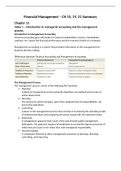Summary
Complete Summary Of Chapters 15, 19 and 21 From The Book of Financial Management 1
- Course
- Institution
You prepare this summary for the Managerial accounting exam during the 2nd block of the first year at International Business at the Hva. Study this summary and you are guaranteed to pass with a grandiose grade!
[Show more]



